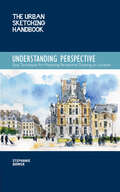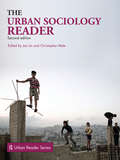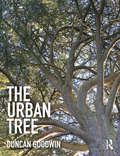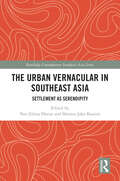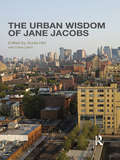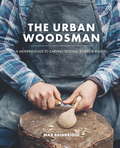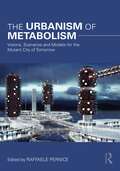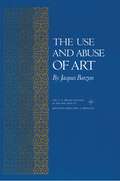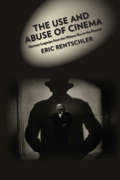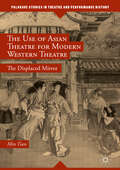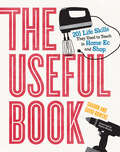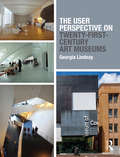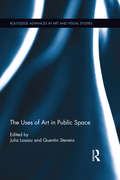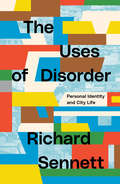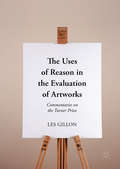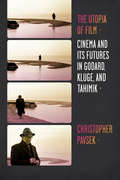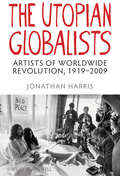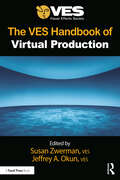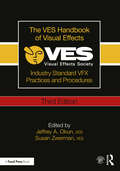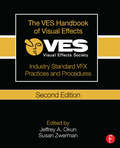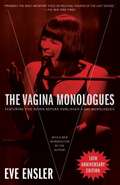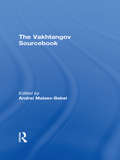- Table View
- List View
The Urban Sketching Handbook: Easy Techniques for Mastering Perspective Drawing on Location (Urban Sketching Handbooks Ser. #4)
by Stephanie BowerA good sketch starts with good bones—this guide from an architectural illustrator shows how to think like an architect and master accurate perspective.This book in the Urban Sketching Handbook series uses drawings and simple steps to explain the often challenging and overwhelming concepts of perspective in practical and useful ways for on-site sketching. Most books are either too abstract or don’t provide enough information that relates to what you actually do when you’re out in the busy, wide world about to start a drawing. Where do you start? How do you edit what you see to flatten and shrink it onto your paper? How does perspective work?The Urban Sketching Handbook: Understanding Perspective helps you learn to think like an architect, to draw buildings and spaces by reducing what you see to simple, basic shapes, then adding layers in simple steps, and finally finishing your sketch with detail, tone, and color—in accurate perspective. Full of helpful tips, it even deconstructs sketches to show you how to create them! Once you understand perspective, it will change the way you see the world—you’ll see perspective everywhere. Key concepts explored in this volume include:Basic Terms * Basic Spatial Principles * Types of Perspective * Building a Sketch in Layers * Special Conditions
The Urban Sociology Reader (Routledge Urban Reader Series)
by Christopher Mele Jan LinThe urban world is an exciting terrain for investigating the central institutions, structures and problems of the social world and how they have transformed through the last 200 years. This Reader comprises sections on urban social theory, racial and social difference in the city, culture in everyday life, culture and the urban economy, globalization and transnational social relations and the regulation of urban space. Drawing together seminal selections covering the nineteenth to the twenty-first centuries, this Reader includes forty-three significant writings from eminent names such as Simmel, Wirth, Park, Burgess, DuBois, Zukin, Sassen, and Harvey. The 2nd edition illuminates more recent urban issues such as sprawl, sustainability, immigration and urban protest. Selections are predominantly sociological, but some readings cross disciplinary boundaries. Providing an essential resource for students of urban studies, this book brings together important but, till now, widely dispersed writings. Editorial commentaries precede each entry; introducing the text, demonstrating its significance, and outlining the issues surrounding its topic, whilst the associated bibliography enables deeper investigations.
The Urban Tree
by Duncan GoodwinThere is a growing evidence base that documents the social, environmental and economic benefits that urban trees can deliver. Trees are, however, under threat today as never before due to competition for space imposed by development, other hard infrastructures, increased pressure on the availability of financial provision from local authorities and a highly cautious approach to risk management in a modern litigious society. It is, therefore, incumbent upon all of us in construction and urban design disciplines to pursue a set of goals that not only preserve existing trees where we can, but also ensure that new plantings are appropriately specified and detailed to enable their successful establishment and growth to productive maturity. Aimed at developers, urban planners, urban designers, landscape architects and arboriculturists, this book takes a candid look at the benefits that trees provide alongside the threats that are eliminating them from our towns and cities. It takes a simple, applied approach that explores a combination of science and practical experience to help ensure a pragmatic and reasoned approach to decision-making in terms of tree selection, specification, placement and establishment. In this way, trees can successfully be incorporated within our urban landscapes, so that we can continue to reap the benefits they provide.
The Urban Vernacular in Southeast Asia: Settlement as Serendipity (Routledge Contemporary Southeast Asia Series)
by Nor Zalina Harun and Shireen Jahn KassimThis book constructs a number of discourses, dialectics and analyses across the disciplines of urban form, architecture and urban experience, thus incorporating both conservation and design issues.It bridges the gap between practice and theory by reconstructing the role of the “village” or “vernacular” in the discourses and trends of the twenty-first century post-Covid19 environment. Bringing together for the first time the confluences of theory and practice in the “urban vernacular” and the “urban village,” the contributors use vernacular concepts and settings as a common framework serving as cultural bridges, connecting traditional forms, ecologies and habitats to new global ideas, industrial economies and access to developing urban sustainability, design, planning and services in Asia's rising megacities. The book begins with concerns of urban layout and morphology, aiming to establish discourse, shared principles and terminology around conventional ideas of the “village” or traditional settlements' apparently organic and disordered nature. It then moves into architectural dimensions, capturing formal cases of how the “vernacular” or traditional “indigenous” local concepts have inspired new ideas in award-winning architecture and hence the importance of re-examining the vernacular in light of the ongoing need to produce a more sustainable and place-conscious fit in modern architecture and urban planning.The book will be of interest to researchers in the fields of architecture, urban planning and design, urban geography, design studies, landscape architecture, history of architecture/urbanism and Asian Studies, in particular those concerning Southeast Asia.
The Urban Wisdom of Jane Jacobs (Planning, History and Environment Series)
by Sonia Hirt Diane ZahmHere for the first time is a thoroughly interdisciplinary and international examination of Jane Jacobs’s legacy. Divided into four parts: I. Jacobs, Urban Philosopher; II. Jacobs, Urban Economist; II. Jacobs, Urban Sociologist; and IV. Jacobs, Urban Designer, the book evaluates the impact of Jacobs’s writings and activism on the city, the professions dedicated to city-building and, more generally, on human thought. Together, the editors and contributors highlight the notion that Jacobs’s influence goes beyond planning to philosophy, economics, sociology and design. They set out to answer such questions as: What explains Jacobs’s lasting appeal and is it justified? Where was she right and where was she wrong? What were the most important themes she addressed? And, although Jacobs was best known for her work on cities, is it correct to say that she was a much broader thinker, a philosopher, and that the key to her lasting legacy is precisely her exceptional breadth of thought?
The Urban Woodsman
by Max BainbridgeHand carving is easy, satisfying and therapeutic when guided by Max Bainbridge. Create your own unique pieces and carve with confidence thanks to detailed information on tools, cutting techniques and clear step-by-step photography accompanying each project. Start with basic spoons, cooking spoons and spatulas, before moving onto butter knives, chopping boards and small bowls, with only a few simple tools required. Max also advises on the perfect finish for your projects - how to sand, ebonise, scorch and texture surfaces as well as waxing and oiling your new creations. Whether you are a novice or an experienced carver, this book will inspire you to make something that you will be proud of.
The Urban Woodsman
by Max BainbridgeHand carving is easy, satisfying and therapeutic when guided by Max Bainbridge. Create your own unique pieces and carve with confidence thanks to detailed information on tools, cutting techniques and clear step-by-step photography accompanying each project. Start with basic spoons, cooking spoons and spatulas, before moving onto butter knives, chopping boards and small bowls, with only a few simple tools required. Max also advises on the perfect finish for your projects - how to sand, ebonise, scorch and texture surfaces as well as waxing and oiling your new creations. Whether you are a novice or an experienced carver, this book will inspire you to make something that you will be proud of.
The Urbanism of Metabolism: Visions, Scenarios and Models for the Mutant City of Tomorrow
by Raffaele PerniceThis edited book explores and promotes reflection on how the lessons of Metabolism experience can inform current debate on city making and future practice in architectural design and urban planning. More than sixty years after the Metabolist manifesto was published, the author’s original contributions highlight the persistent links between present and past that can help to re-imagine new urban futures as well as the design of innovative intra-urban relationships and spaces. The essays are written by experienced scholars and renowned academics from Japan, Australia, Europe, South Korea and the United States and expose Metabolism’s special merits in promoting new urban models and evaluate the current legacy of its architectural projects and urban design lessons. They offer a critical, intellectual, and up-to-date account of the Metabolism projects and ideas with regard to the current evolution of architectural and urbanism discourse in a global context. The collection of cross-disciplinary contributions in this volume will be of great interest to architects, architectural and urban historians, as well as academics, scholars and students in built environment disciplines and Japanese cultural studies.
The Use and Abuse of Art (The A. W. Mellon Lectures in the Fine Arts #73)
by Jacques BarzunThe lecturer traces the historical development of attitudes toward the arts over the past 150 years, suggesting that the present is a period of cultural liquidation, nothing less than the ending of the modern age that began with the Renaissance.
The Use and Abuse of Cinema: German Legacies from the Weimar Era to the Present (Film and Culture Series)
by Eric RentschlerEric Rentschler's new book, The Use and Abuse of Cinema, takes readers on a series of enthralling excursions through the fraught history of German cinema, from the Weimar and Nazi eras to the postwar and postwall epochs and into the new millennium. These journeys afford rich panoramas and nuanced close-ups from a nation's production of fantasies and spectacles, traversing the different ways in which the film medium has figured in Germany, both as a site of creative and critical enterprise and as a locus of destructive and regressive endeavor. Each of the chapters provides a stirring minidrama; the cast includes prominent critics such as Siegfried Kracauer and Rudolf Arnheim; postwar directors like Wolfgang Staudte, Rainer Werner Fassbinder, Wim Wenders, and Alexander Kluge; representatives of the so-called Berlin School; and exponents of mountain epics, early sound musicals, rubble films, and recent heritage features. A film history that is both original and unconventional, Rentschler's colorful tapestry weaves together figures, motifs, and stories in exciting, unexpected, and even novelistic ways.
The Use of Asian Theatre for Modern Western Theatre: The Displaced Mirror (Palgrave Studies in Theatre and Performance History)
by Min TianThis book is a historical study of the use of Asian theatre for modern Western theatre as practiced by its founding fathers, including Aurélien Lugné-Poe, Adolphe Appia, Gordon Craig, W. B. Yeats, Jacques Copeau, Charles Dullin, Antonin Artaud, V. E. Meyerhold, Sergei Eisenstein, and Bertolt Brecht. It investigates the theories and practices of these leading figures in their transnational and cross-cultural relationship with Asian theatrical traditions and their interpretations and appropriations of the Asian traditions in their reactional struggles against the dominance of commercialism and naturalism. From the historical and aesthetic perspectives of traditional Asian theatres, it approaches this intercultural phenomenon as a (Euro)centred process of displacement of the aesthetically and culturally differentiated Asian theatrical traditions and of their historical differences and identities. Looking into the displaced and distorted mirror of Asian theatre, the founding fathers of modern Western theatre saw, in their imagination of the 'ghostly' Other, nothing but a (self-)reflection or, more precisely, a (self-)projection and emplacement, of their competing ideas and theories preconceived for the construction, and the future development, of modern Western theatre.
The Useful Book: 201 Life Skills They Used to Teach in Home Ec and Shop
by David Bowers Sharon BowersA modern and energetically designed encyclopedia of DIY with everything you need to know to roll up your sleeves and cook it, build it, sew it, clean it, or repair it yourself. In other words, everything you would have learned from your shop and home ec teachers, if you'd had them.The Useful Book features 138 practical projects and how-tos, with step-by-step instructions and illustrations, relevant charts, sidebars, lists, and handy toolboxes. There’s a kitchen crash course, including the must-haves for a well-stocked pantry; how to boil an egg (and peel it frustration-free); how to grill, steam, sauté, and roast vegetables. There’s Sewing 101, plus how to fold a fitted sheet, tie a tie, mop a floor, make a bed, and set the table for a formal dinner. Next up: a 21st-century shop class. The tools that everyone should have, and dozens of cool projects that teach fundamental techniques. Practice measuring, cutting, and nailing by building a birdhouse. Make a bookshelf or a riveted metal picture frame. Plus: do-it-yourself plumbing; car repair basics; and home maintenance, from priming and painting to refinishing wood floors.
The User Perspective on Twenty-First-Century Art Museums
by Georgia LindsayThe User Perspective on Twenty-First Century Art Museums explains contemporary museums from the whole gamut of user experiences, whether users are preserving art, creating an exhibit, visiting, or part of institutions that use the architecture for branding. Fourteen museums from the United States, Europe, China, and Australia represent new construction, repurposed buildings, and additions, offering examples for most museum design situations. Each is examined using interviews with key stakeholders, photographs, and analyses of press coverage to identify lessons from the main user groups. User groups vary from project to project depending on conditions and context, so each of the four parts of the book features a summary of the users and issues in that section for quick reference. The book concludes with a practical, straightforward lessons-learned summary and a critical assessment of twenty-first-century museum architecture, programming, and expectations to help you embark on a new building design. Architects, architecture students, museum professionals, and aficionados of museum design will all find helpful insights in these lessons and critiques.
The Uses of Art in Public Space (Routledge Advances in Art and Visual Studies)
by Julia Lossau Quentin StevensThis book links two fields of interest which are too seldom considered together: the production and critique of art in public space and social behaviour in the public realm. Whilst most writing about public art has focused on the aesthetic, cultural and political intentions and processes that shape its production, this edited collection examines a variety of public artworks from the perspective of their actual everyday use. Contributors are interested in the rich diversity of peoples’ engagements with public artworks across various spatial and temporal scales, encounters which do not limit themselves to the representational aspects of the art, and which are not necessarily as the artist, curator or sponsor intended. Case studies consider a broad range of public art, including commissioned and unofficial artworks, memorials, street art, street furniture, performance art, sound art and media installations.
The Uses of Disorder: Personal Identity and City Life
by Richard SennettReissue of the classic text on how cities should be plannedWhen first published in 1970, The Uses of Disorder, was a call to arms against the deadening hand of modernist urban planning upon the thriving chaotic city. Written in the aftermath of the 1968 student uprising in the US and Europe, it demands a reimagination of the city and how class, city life and identity combine. Too often, this leads to divisions, such as the middle class flight to the suburbs, leaving the inner cities in desperate straits. In response, Sennett offers an alternative image of a "dense, disorderly, overwhelming cities" that allow for change and the development of community. Fifty years later this book is as essential as it was when it first came out, and remains an inspiration to architects, planners and urban thinkers everywhere.
The Uses of Reason in the Evaluation of Artworks: Commentaries on the Turner Prize
by Les GillonThis book uses an examination of the annual Turner Prize to defend the view that the evaluation of artworks is a reason-based activity, notwithstanding the lack of any agreed criteria for judging excellence in art. It undertakes an empirical investigation of actual critical practice as evident within published commentaries on the Prize in order to examine and test theories of critical evaluation, including the ideas of Noel Carroll, Frank Sibley, Kendall Walton and Suzanne Langer. Case studies of work by Turner Prize winners such as Steve McQueen, Martin Creed, Tomma Abts are used to explore definitions of art and concepts of artistic value and meaning. The book will be of interest to academics in the fields of aesthetics, contemporary art and cultural studies, but also to practitioners working in the arts, media and education.
The Utopia of Film: Cinema and Its Futures in Godard, Kluge, and Tahimik (Film and Culture Series)
by Christopher PavsekThe German filmmaker Alexander Kluge has long promoted cinema's relationship with the goals of human emancipation. Jean-Luc Godard and Filipino director Kidlat Tahimik also believe in cinema's ability to bring about what Theodor W. Adorno once called a "redeemed world." Situating the films of Godard, Tahimik, and Kluge within debates over social revolution, utopian ideals, and the unrealized potential of utopian thought and action, Christopher Pavsek showcases the strengths, weaknesses, and undeniable impact of their utopian visions on film's political evolution. He discusses Godard's Alphaville (1965) against Germany Year 90 Nine-Zero (1991) and JLG/JLG: Self-portrait in December (1994), and he conducts the first scholarly reading of Film Socialisme (2010). He considers Tahimik's virtually unknown masterpiece, I Am Furious Yellow (1981–1991), along with Perfumed Nightmare (1977) and Turumba (1983); and he constructs a dialogue between Kluge's Brutality in Stone (1961) and Yesterday Girl (1965) and his later The Assault of the Present on the Rest of Time (1985) and Fruits of Trust (2009).
The Utopian Globalists
by Jonathan HarrisAn innovative history and critical account mapping the ways artists and their works have engaged with, and offered commentary on, modern spectacle in both capitalist and socialist modernism over the past ninety years.Focuses on artists whose work expresses the concept of revolutionary social transformation Provides a strong historical narrative that adds structure and clarityFeatures a cogent and innovative critique of contemporary art and institutionsCovers 100 years of art from Vladimir Tatlin's constructivist 'Monument to the Third International', to Picasso's late 1940s commitment to Communism, to the Unilever Series sponsored Large Artworks installed at London's Tate Modern since 2000.Includes the only substantial account in print of John Lennon and Yoko Ono's 1969 Montreal 'Bed-in'Offers an accessible description and interpretation of Debord's 'society of the spectacle' theory
The VES Handbook of Virtual Production
by Jeffrey A. Okun Susan Zwerman Susan Thurmond O’NealThe VES Handbook of Virtual Production is a comprehensive guide to everything about virtual production available today – from pre-production to digital character creation, building a stage, choosing LED panels, setting up Brain Bars, in-camera compositing of live action and CG elements, Virtual Art Departments, Virtual Previs and scouting, best practices and much more. Current and forward-looking, this book covers everything one may need to know to execute a successful virtual production project – including when it is best to use virtual production and when it is not. More than 80 industry leaders in all fields of virtual production share their knowledge, experiences, techniques, and best practices. The text also features charts, technical drawings, color images, and an extensive glossary of virtual production terms. The VES Handbook of Virtual Production is a vital resource for anyone wishing to gain essential knowledge in all aspects of virtual production. This is a must-have book for both aspiring and veteran professionals. It has been carefully compiled by the editors of The VES Handbook of Visual Effects.
The VES Handbook of Virtual Production
by Jeffrey A. Okun Susan Zwerman Susan Thurmond O’NealOur handbook on Virtual Production is written in conjunction with the Visual Effects Society, guaranteeing the most expert advice in all areas of Virtual Production. It is a first of its kind handbook on this nascent technology, pooling insights from a vast array of different practitioners, to create a truly comprehensive reference book. It covers not only the software, hardware, and workflows, but also the types of jobs training needed for VP – the book starts from the ground up and provides an overview of what you need to learn before you use this technology.
The VES Handbook of Visual Effects: Industry Standard VFX Practices and Procedures
by Jeffrey A. Okun Susan Zwerman Christopher McKittrick Lisa Sepp-WilsonThe award-winning VES Handbook of Visual Effects remains the most complete guide to visual effects techniques and best practices available today. This new edition has been updated to include the latest, industry-standard techniques, technologies, and workflows for the ever-evolving fast paced world of visual effects. The Visual Effects Society (VES) tasked the original authors to update their areas of expertise, such as AR/VR moviemaking, color management, Cameras, VFX Editorial, Stereoscopic and the Digital Intermediate, as well as provide detailed chapters on interactive games and full animation. Additionally, 56 contributors share their best methods, tips, tricks, and shortcuts developed through decades of trial and error and real-world, hands-on experience. This 3rd edition has been expanded to feature lessons on 2.5D/3D Compositing; 3D Scanning; Digital Cinematography; Editorial Workflow in Animated and Visual Effects Features; Gaming updates; General Geometry Instancing; Lens Mapping for VFX; Native Stereo; Real-Time VFX & Camera Tracking; Shot/Element Pulls and Delivery to VFX; Techvis; VFX Elements and Stereo; Virtual Production; and VR/AR (Virtual Reality / Augmented Reality). A must-have for anyone working in or aspiring to work in visual effects, The VES Handbook of Visual Effects, Third Edition covers essential techniques and solutions for all VFX artists, producers, and supervisors, from pre-production to digital character creation, compositing of both live-action and CG elements, photorealistic techniques, and much more. With subjects and techniques clearly and definitively presented in beautiful four-color, this handbook is a vital resource for any serious VFX artist.
The VES Handbook of Visual Effects: Industry Standard VFX Practices and Procedures
by Jeffrey A. Okun Susan Zwerman Christopher McKittrick Lisa Sepp-WilsonThe award-winning VES Handbook of Visual Effects remains the most complete guide to visual effects techniques and best practices available today. This new edition has been updated to include the latest, industry-standard techniques, technologies, and workflows for the ever-evolving fast paced world of visual effects. The Visual Effects Society (VES) tasked the original authors to update their areas of expertise, such as AR/VR Moviemaking, Color Management, Cameras, VFX Editorial, Stereoscopic and the Digital Intermediate, as well as provide detailed chapters on interactive games and full animation. Additionally, 56 contributors share their best methods, tips, tricks, and shortcuts developed through decades of trial and error and real-world, hands-on experience.This third edition has been expanded to feature lessons on 2.5D/3D Compositing; 3D Scanning; Digital Cinematography; Editorial Workflow in Animated and Visual Effects Features; Gaming updates; General Geometry Instancing; Lens Mapping for VFX; Native Stereo; Real-Time VFX and Camera Tracking; Shot/Element Pulls and Delivery to VFX; Techvis; VFX Elements and Stereo; Virtual Production; and VR/AR (Virtual Reality / Augmented Reality).A must-have for anyone working in or aspiring to work in visual effects, The VES Handbook of Visual Effects, Third Edition covers essential techniques and solutions for all VFX artists, producers, and supervisors, from pre-production to digital character creation, compositing of both live-action and CG elements, photorealistic techniques, and much more. With subjects and techniques clearly and definitively presented in beautiful four-color, this handbook is a vital resource for any serious VFX artist.
The VES Handbook of Visual Effects: Industry Standard VFX Practices and Procedures
by Jeffrey A. Okun Susan ZwermanWisdom from the best and the brightest in the industry, this visual effects bible belongs on the shelf of anyone working in or aspiring to work in VFX. The book covers techniques and solutions all VFX artists/producers/supervisors need to know, from breaking down a script and initial bidding, to digital character creation and compositing of both live-action and CG elements. In-depth lessons on stereoscopic moviemaking, color management and digital intermediates are included, as well as chapters on interactive games and full animation authored by artists from EA and Dreamworks respectively. From predproduction to acquisition to postproduction, every aspect of the VFX production workflow is given prominent coverage. VFX legends such as John Knoll, Mike Fink, and John Erland provide you with invaluable insight and lessons from the set, equipping you with everything you need to know about the entire visual effects workflow. Simply a must-have book for anyone working in or wanting to work in the VFX industry.
The Vagina Monologues (10th Anniversary Edition)
by Eve Ensler"I was worried about vaginas. I was worried about what we think about vaginas, and even more worried that we don't think about them... So I decided to talk to women about their vaginas, to do vagina interviews, which became vagina monologues. I talked with over two hundred women. I talked to old women, young women, married women, single women, lesbians, college professors, actors, corporate professionals, sex workers, African American women, Hispanic women, Asian American women, Native American women, Caucasian women, Jewish women. At first women were reluctant to talk. They were a little shy. But once they got going, you couldn't stop them." So begins Eve Ensler's hilarious, eye-opening tour into the last frontier, the forbidden zone at the heart of every woman. Adapted from the award-winning one-woman show that's rocked audiences around the world, this groundbreaking book gives voice to a chorus of lusty, outrageous, poignant, and thoroughly human stories, transforming the question mark hovering over the female anatomy into a permanent victory sign. With laughter and compassion, Ensler transports her audiences to a world we've never dared to know, guaranteeing that no one who reads The Vagina Monologues will ever look at a woman's body the same way again.
The Vakhtangov Sourcebook
by Andrei Malaev-Babel‘Scrupulously compiled and skillfully translated by Andrei Malaev-Babel, The Vakhtangov Sourcebook ... provides the most comprehensive addition to English readers’ knowledge of the philosophy, pedagogy, and legacy of Vakhtangov.’ – Modern Language Review 'An exceptionally valuable book that promises to be the definitive reference for Vakhtangov's work for years to come.' – Theatre Topics Yevgeny Vakhtangov was the creator of Fantastic Realism, credited with reconciling Meyerhold’s bold experiments with Stanislavski’s naturalist technique. The Vakhtangov Sourcebook compiles new translations of his key writings on the art of theatre, making it the primary source of first hand material on this master of theatre in the English speaking world. Vakhtangov’s essays and articles are accompanied by: Diary and Notebook excerpts His lectures to the Vakhtangov Studio In-depth accounts of Vakhtangov methods in rehearsal Production photographs and sketches Extensive bibliographies Director’s notes on key performances An extensive introductory overview from editor Andrei Malaev-Babel explains Vakhtangov‘s creative life, his groundbreaking theatrical concepts and influential directorial works.
